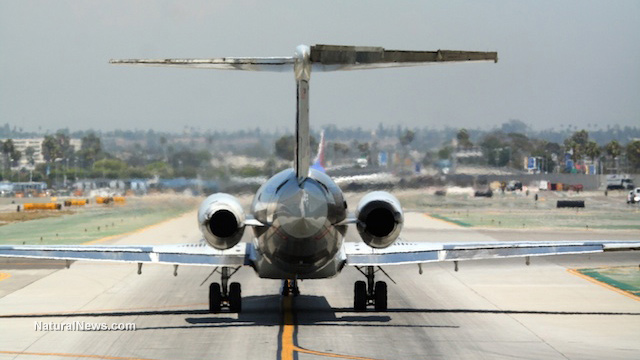US military converting transport planes to carry wave of infected Ebola victims to the United States
Thursday, December 11, 2014 by: J. D. Heyes
Tags: Ebola victims, US military, transport planes

- Newly released JFK files reveal Pentagon's role in creating Lyme disease and covid in the same lab
- Discovery of vast underground city beneath Giza pyramids challenges human history
- Black cumin seed oil emerges as a powerful ally against breast cancer and chronic inflammation
- Sugar-free deception: Artificial sweeteners hijack hunger signals, fuel obesity epidemic, study warns
- Kiss Your Genetic Privacy Good-Bye! 23andMe Gets Green Light to Sell Your Intimate Genetic Details to Anyone They Want
- Aluminum pollution: A silent threat to human health
- Dr. Suzanne Humphries makes bombshell appearance on Joe Rogan podcast, exposing vaccine industry deception back to POLIOMYELITIS
- Sweden's migrant crisis deepens as failed green energy venture leaves thousands jobless, exposes systemic collapse
- Is the vaccine-autism debate reopening? Washington Post sparks controversy with preemptive hit piece on David Geier
- Analysis: The coming economic collapse, a mass uprising and Trump's three secret weapons to halt the growing revolt
- A handful of pecans a day could keep heart disease at bay, study finds
- The mighty Eggplant: An underrated superfood with ancient roots
- The great crypto power struggle: How technocrats and governments are reshaping global finance
- Challenging the status quo: “America Fooled” by Timothy Scott exposes the myths about antidepressants
- RFK Jr. slashes HHS bureaucracy, saves taxpayers $1.8B while refocusing on chronic disease epidemic
- AI breakthrough slashes celiac disease diagnosis time from months to minutes
- Understanding the difference: “Food Allergies and Food Intolerance” by Dr. Jonathan Brostoff and Linda Gamlin
- HIGH-FAT FOOD DEPRESSION: Scientists discover why obesity takes away the pleasure of eating
- Newly released JFK files reveal Pentagon's role in creating Lyme disease and covid in the same lab
- Analysis: The coming economic collapse, a mass uprising and Trump's three secret weapons to halt the growing revolt
- Trump nominates VACCINE ZEALOT Susan Monarez to lead the CDC, sidelining RFK Jr.'s reform efforts
- Trump's greatest betrayal so far: Accelerating Middle East wars, silencing dissent, and serving Zionist masters
- Dr. Mike Yeadon releases 15-minute testimony - WATCH - about genocidal intent of COVID “vaccines”
- Festive flavors: The sweet history, nutritional profile and health benefits of pecan pie
- Elon Musk: Aliens could be here on Earth RIGHT NOW
- Big Pharma's $8 Billion bribery scheme exposed: how doctors are pushed to prescribe junk science, not heal
- 5 Simple steps to boost your brainpower: How to strengthen executive function in a distracted world
- Trump reverses course on Gaza plan, says “nobody is expelling Palestinians”
- A lack of integrity in Academia: Harvard professor found GUILTY of fraudulent research to promote CRT theory
- Reclaim your health: How midlife exercise reverses years of inactivity
- Survival 101: Effective EMF blocking techniques
- Florida takes a stand: DeSantis proposes permanent ban on mRNA vaccine mandates
- Sugarcane extract superior to cholesterol-lowering drugs?
- California's social media censorship law struck down: A victory for free speech or a threat to online safety?
- OpenAI whistleblower who dissented against how the company trained ChatGPT found dead
- EPA advisor admits the agency is funneling billions to climate groups ahead of Trump’s return to White House
- EPA advisor admits the agency is funneling billions to climate groups ahead of Trump’s return to White House
- Newly released JFK files reveal Pentagon's role in creating Lyme disease and covid in the same lab
- California's social media censorship law struck down: A victory for free speech or a threat to online safety?
- Dr. Mike Yeadon releases 15-minute testimony - WATCH - about genocidal intent of COVID “vaccines”
- The Health Ranger releases “Vaccine Zombie” song and music video, using AI-animated zombies for the music video
- The pandemic as a tool for INDOCTRINATION: Understanding “The Indoctrinated Brain” by Dr. Michael Nehls
- Florida takes a stand: DeSantis proposes permanent ban on mRNA vaccine mandates
- “Why we influenced the 2020 elections”: Facebook files reveal the coordinated effort to bury the Hunter Biden laptop story
- Mike Adams releases country western hit single: Goin’ Back in Time is Comin’ Home
- Mike Adams releases music poetry sensation: A Child of God
- Unpacking the Lies That We’ve Been Fed – new song and music video released by Mike Adams, the Health Ranger
- Michigan sheriff announces criminal investigation into 2020 election crimes, Dominion Voting Systems
- Migrants are taking advantage of recent hurricanes to scam residents and loot their homes
- House Intelligence Committee calls for the ARREST and PROSECUTION of Dr. Anthony Fauci
- RFK Jr. clears key hurdle: Sen. Susan Collins backs controversial HHS nominee, signaling a new era for health policy
- Rep. Nancy Mace introduces bill to ban biological males from female facilities on federal property
- Peter Rost exposes Big Pharma corruption in his book “The Whistleblower: Confessions of a Healthcare Hitman”
- Mike Adams releases new song and music video: Nothing More Disgusting Than a Globalist
- Red Cross issues warning to stop blood plasma donations from vaccinated people
- Scientists confirm: GENIUS brain function can be spontaneously unleashed in humans without any apparent cause
- EPA advisor admits the agency is funneling billions to climate groups ahead of Trump’s return to White House
- HYSSOP: What research reveals about the health benefits of this ancient holy herb
- Two containers with completed ballots fall out of truck in Florida
- Fully vaccinated about to see “tsunami” of illness and death, warns virologist
- Global leaders unite to clamp down on “misinformation” with UN-backed Cascais Declaration
- BREAKING: 2025 NDAA authorizes mandatory military draft of WOMEN across America… as Pentagon pursues global NUCLEAR war with both Russia and China at the same time
- Michael Yon warns of a ZIONIST TAKEOVER in Trump’s second administration
- BOMBSHELL: DNA testing kits are a SCAM to develop ethnic-specific bioweapons
- Ozempic and Wegovy weight loss drugs are injectable LIZARD VENOM PEPTIDES that may unleash a devastating wave of organ failure… side effects align with symptoms of SNAKE BITES
- Israeli soldiers accused of even more torture and abuse in the West Bank
- These 13 countries just signed an agreement to engineer a global FAMINE by destroying food supply
- NASA admits that climate change occurs because of changes in Earth’s solar orbit, and NOT because of SUVs and fossil fuels
- RFK Jr. clears key hurdle: Sen. Susan Collins backs controversial HHS nominee, signaling a new era for health policy
- Sermon 30: How Jesus reveals Caesar’s FAKE CURRENCY and FALSE AUTHORITY
- Coriander seeds: Ancient medicine backed by modern science
- Arizona officials claim Maricopa County needs 10-13 days to tabulate results of the election
As most Americans know, the president has ordered thousands of U.S. troops to Ebola-plagued West Africa, a move that critics have said not only misappropriates American military personnel but also put their lives needlessly at risk -- though so far, no reports of American servicemen or women being sickened by Ebola have surfaced.
Now, it appears as though the U.S. Air Force has been ordered to modify scarce transport planes to be able to transport patients stricken with the deadly virus.
According to a recent report from BusinessWeek, the military will be outfitting an untold number of aircraft with new isolation chambers designed to safely carry as many as a dozen people infected with the virus (transporting those with deadly diseases likely wasn't something that Air Force recruiters thought to bring up with pilots and air crew chiefs when they were enlisting).
"That is a new capability that will be available in the next couple of weeks," Air Force Gen. Paul Selva, head of the Transportation Command, told reporters.
Thousands of U.S. military personnel ordered to the hot zone
The prototype chamber was designed and manufactured by Production Products Manufacturing & Sales Co., which is a closely-held St. Louis-based firm that makes safety and protective outerwear and shelters.
As BusinessWeek further reported:
The U.S. military has deployed 2,900 personnel to Western Africa to set up communications, provide logistics capabilities and build treatment centers and hospitals.
Program documents don't specify whether the system is intended only for the transport of U.S. military personnel or will be available for infected civilians.
President Obama ordered up to 4,000 U.S. military personnel to West Africa, to build treatment facilities and, now, apparently, to transport Ebola victims from the plagued region to treatment facilities.
While the spread of the virus has slowed in some regions of the hardest-hit countries of Sierra Leone, Guinea and Liberia, Ebola has infected more than 17,500 people since the current outbreak began about 10 months ago. Of those, 6,202 have died as of Dec. 3, according to the World Health Organization. Some reports have suggested that those figures are low, due to often spotty reporting.
In a separate report, the Defense Department said the effort to outfit the planes was initiated through the U.S. Transportation Command, working in conjunction with the Department of Health and Human Services and the Defense Threat Reduction Agency. Prior to the current outbreak, Selva, who is head of Transportation Command, or TransCom, said the U.S. military did not have the capacity to transport Ebola patients.
"We have the capacity to isolate a single person and that capacity was designed exclusively to handle a SARS patient," Selva told the Defense Writers' Group, according DoD News.
We wanted to protect our people as well
Reports said that four of the "transport isolation systems" are designed to be carried aboard Boeing C-17 transport aircraft, and one aboard a C-130 plane, manufactured by Lockheed Martin. On the larger C-17, Selva said as many as eight patients on stretchers could fit in the isolation unit, or 12 who are still able to walk.
DoD News added further:
Over the last 60 days, the command put a requirement on the street for a transportation/isolation module system. That system would load aboard a C-17 or a C-130. The module would isolate the patient, filter the air that moves through the compartment, and would allow access to treat the patient that has a communicable disease that is airborne, or, in the case of Ebola, fluid-borne.
"It accommodates the Ebola issue, but it also accommodates airborne contagions," Selva said.
He added: "Our approach was if we are going to put military members in harm's way, the capacity to move a single patient at a time was insufficient to the mission we were asking our team to do. We put an urgent operational needs statement together and challenged industry and the defense engineering community to come up with an operational solution for it. And in 60 days, they've delivered a solution that looks like it will work."
Learn all these details and more at the FREE online Pandemic Preparedness course at www.BioDefense.com
Sources:
http://www.businessweek.com
http://www.defense.gov
http://www.usatoday.com
http://www.cdc.gov
http://science.naturalnews.com
Ebola victims at FETCH.news
Get independent news alerts on natural cures, food lab tests, cannabis medicine, science, robotics, drones, privacy and more.
Take Action: Support Natural News by linking to this article from your website
Permalink to this article:
Embed article link: (copy HTML code below):
Reprinting this article:
Non-commercial use OK, cite NaturalNews.com with clickable link.
Follow Natural News on Facebook, Twitter, Google Plus, and Pinterest
Science News & Studies
Medicine News and Information
Food News & Studies
Health News & Studies
Herbs News & Information
Pollution News & Studies
Cancer News & Studies
Climate News & Studies
Survival News & Information
Gear News & Information
News covering technology, stocks, hackers, and more



"Big Tech and mainstream media are constantly trying to silence the independent voices that dare to bring you the truth about toxic food ingredients, dangerous medications and the failed, fraudulent science of the profit-driven medical establishment.
Email is one of the best ways to make sure you stay informed, without the censorship of the tech giants (Google, Apple, Facebook, Twitter, YouTube, etc.). Stay informed and you'll even likely learn information that may help save your own life."
–The Health Ranger, Mike Adams













































